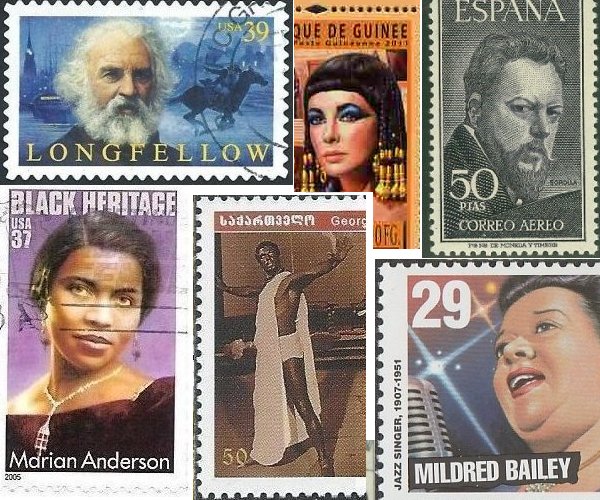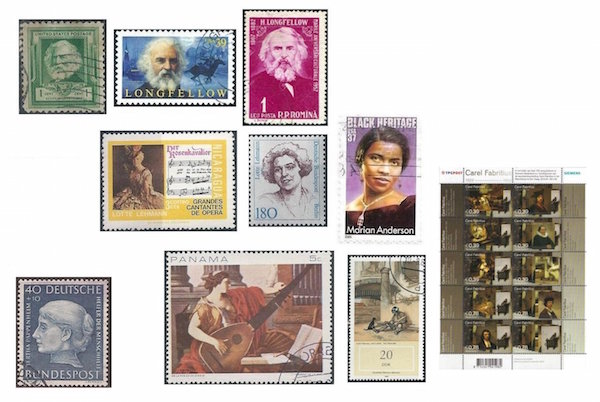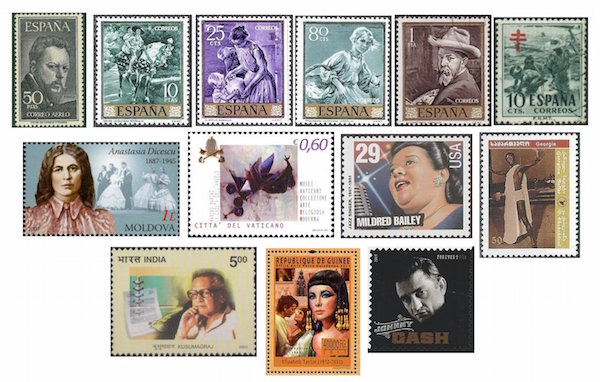The Arts on the Stamps of the World — February 27
An Arts Fuse regular feature: the arts on stamps of the world.

By Doug Briscoe
For this February 27 we acknowledge Henry Wadsworth Longfellow, two very great singers, Lotte Lehmann and Marian Anderson, two seventeenth-century painters, and several others, including Mildred Bailey and actress Elizabeth Taylor. Also, I missed Johnny Cash’s birthday yesterday and offer him a belated Happy Birthday today.
Henry Wadsworth Longfellow (February 27, 1807 – March 24, 1882), like his friend James Russell Lowell, was one of the five Fireside Poets. When Longfellow was born, his hometown of Portland, now in Maine, was then in a separate part of Massachusetts. He studied at Bowdoin and taught there and, like Lowell, at Harvard, where he, too, worked in modern languages. He was the first American to translate Dante’s Divine Comedy, as well as works from Latin (Horace), French, Spanish, German, and maybe more (he studied Dutch, Danish, Swedish, Finnish, and Icelandic!). In view of his extensive work in this area, Harvard established the Longfellow Institute in 1994, “dedicated to literature written in the United States in languages other than English.” Longfellow’s poems provided composers with a great many opportunities for musical expression. Most of these composers are frankly obscure 19th-century Americans, but the list of distinguished composers includes: Liszt, Gounod, Arthur Sullivan, Elgar (whose music for The Black Knight is set to Longfellow’s translation of Uhland), and Britten (who set “Beware” in 1923, when he was all of ten years old). One of Samuel Coleridge-Taylor’s most highly regarded works, the cantata trilogy, “The Song of Hiawatha”, is set to Longfellow’s famous words. After his retirement in 1854, Longfellow settled permanently in Cambridge. Today you can visit the house at 105 Brattle Street.
Soprano Charlotte “Lotte” Lehmann (1888 – August 26, 1976) specialized in the German repertoire, being particularly noted for her Marschallin, Sieglinde, and Fidelio, as well as for her sublime Lieder singing. She made over five hundred recordings. She has a star on the Hollywood Walk of Fame (where her name is misspelled “Lottie”), and a Lotte Lehmann Academy was established in her home town of Perleburg, Germany in 2009.
Our next great singer was American contralto and important civil rights figure Marian Anderson (1897 – April 8, 1993). Encountering racist resistance, she went to Europe in the 30s, meeting and befriending Sibelius. Her success there was such that Sol Hurok offered her a lucrative contract and persuaded her to return to the U.S., where she sang to rave reviews at Town Hall in New York. On being denied by the DAR the chance to sing in their hall, she was invited by the Roosevelts to perform on the steps of the Lincoln Memorial in an historic concert of April 9, 1939, which was attended by some 75,000 people and heard over the radio by millions. She was also the first black person to perform at the Met (but that had to wait until January 7, 1955). On account of her self-doubts regarding her acting ability, however, she preferred concert venues and otherwise never appeared in an opera on stage. She sang at the March on Washington in 1963. Her nephew was the late American conductor James DePreist (1936–2013).
Our two seventeenth-century painters are Laurent de la Hyre (1606 – 28 December 1656) and Carel Pieterszoon Fabritius (who was baptized on this day in 1622). La Hyre, influenced by Italian artists who came to Paris, is seen as belonging to a transitional period between the later Renaissance and the Baroque as introduced in France by Simon Vouet. He was one of the dozen founders of the French Royal Academy of Painting and Sculpture in 1646. Nine of his pieces hang in The Louvre. This lovely Allegory of Music, from 1649, reproduced on a Panamanian stamp, is in the Metropolitan Museum of Art. For a fuller appreciation of the detail and gorgeous color palette in this painting, visit their Web site.

Fabritius was a Dutch pupil of Rembrandt, but prior to that started work as a carpenter (Latin: fabritius). After leaving Rembrandt’s Amsterdam studio, Fabritius went to Delft and joined the painters’ guild there in 1652. Wikipedia says that “[of] all Rembrandt’s pupils, Fabritius was the only one to develop his own artistic style…[characterized by] delicately lit subjects against light-colored, textured backgrounds.” Sadly he was killed, along with a hundred others, when the Delft gunpowder magazine exploded on October 12, 1654. His studio and many of his paintings were lost in the conflagration. This incident is related in the Pulitzer Prize-winning novel The Goldfinch (2013) by Donna Tartt. One of Fabritius’s surviving works is The Sentry (1654), as seen on an East German stamp (the painting hangs in the Staatliches Museum in Schwerin) from 1982. There is also the beautiful souvenir sheet of ten stamps issued by the Netherlands—I can’t find a good-sized image online but include this small one just to give you a general idea of its appearance.
Today is also the birthday of Bertha Pappenheim (February 1859 – May 28, 1936), founder of the Jewish Women’s Association and an extremely important subject (“Anna O.”) for Josef Breuer and Sigmund Freud’s analysis of what they used to call “hysteria”. For Arts Fuse purposes, Pappenheim, an ardent feminist and social worker who translated Mary Wollstonecraft, wrote stories, plays, and poems. But in addition she accomplished so much more: as director of a Jewish girls’ orphanage she redirected the curriculum from what was essentially How to Get a Husband to vocational training, and she served as president of the Jüdischer Frauenbund (JFB, League of Jewish Women, concerned more with Jewish culture than on encouraging assimilation or fighting antisemitism) until her death. Her writings include Little Stories for Children (1888), another story collection called In the Junk Shop (1890), and a play on the Jewish experience, Tragische Momente. Drei Lebensbilder (Tragic Moments. Three Scenes from Life; 1913).
A beloved Spanish painter, Joaquín Sorolla y Bastida (1863 – 10 August 1923) is our next subject. Born in Valencia, Sorolla was orphaned at the age of two and, with his even younger sister, was cared for by an aunt and uncle. Early on he developed an interest in painting and at eighteen undertook a trip to Madrid to study works in the Prado, thereafter receiving a grant for further study in Rome and then encountering modern painting in Paris. His piece Another Marguerite(1892) won a gold medal at the National Exhibition in Madrid and first prize at the Chicago International Exhibition. Most of his work is of domestic or rural scenes, but one of his most extraordinary pieces depicts disabled children visiting a beach in Valencia. This painting, Sad Inheritance (1899), is thought to be the first ever to portray polio victims. (An epidemic had struck Velancia some years earlier.) It won for Sorolla the Grand Prix and a medal of honor at the Universal Exhibition in Paris in 1900 and the medal of honor at the National Exhibition in Madrid in 1901. An issue of ten stamps, including one showing a self-portrait, appeared in Spain in 1964 (I show four of these), and another of his works, Children on the Seashore (1903), was chosen to illustrate a tax stamp to help fight tuberculosis.
Today’s third singer (second collage, second row) died of tuberculosis in her late fifties. Romanian soprano Anastasia Dicescu (1887 – 1945) was of Lotte Lehmann’s generation. She studied at Odessa, St. Petersburg, and Rome, but mainly performed in her homeland. She taught at two conservatories in Chişinău (was director of one of them) and an academy in Bucarest. Her best known rôles included Violetta in La Traviata, Gilda in Rigoletto, Marguerite in Faust, and Rosina in The Barber of Seville (we celebrate Rossini’s 29 Feb. birthday tomorrow).
The Italian sculptor Marino Marini (1901 – 6 August 1980) was also a painter and never abandoned that art, but largely devoted himself to sculpture from about 1922. His work in that genre often shows the influence of Etruscan art, for example, The Pilgrim. The stamp, however, from the Vatican, shows his canvas La caduta dell’angelo (The Fall of the Angel) of 1963. The city of Florence has a museum dedicated to Marini’s work.

Mildred Bailey (née Rinker; 1907 – December 12, 1951) was called “The Queen of Swing”. Her parents were musical, and her brothers, vocalist and composer Al Rinker and lyricist Charles Rinker, also came to prominence in music. Mildred demonstrated sheet music at a Seattle Woolworth’s and went on to a career singing blues and jazz on the West Coast. She met her brother Al’s partner Bing Crosby, who introduced her to Paul Whiteman, and she ended up singing with Whiteman’s band from 1929 to 1933. She and her third husband Red Norvo came to be known as “Mr. and Mrs. Swing”. She can also be heard on some of Benny Goodman’s 1939-40 recordings for Columbia, but she made very few records after the war.
Vakhtang Chabukiani (1910 – April 6, 1992) was described in a New York Times obituary as one of “the great dancers of his generation.” He and Tatyana Vecheslova were the first Soviet dancers to tour in the United States. Also a choreographer and teacher, he directed and appeared in a number of Soviet ballet films. The Georgian stamp shows him as Othello, his film of which was made in 1960.
The Marathi writer popularly known as Kusumagraj was born Gajanan Ranganath Shirwadkar on this day in 1912 in Pune, near India’s western coast. After adoption, he became Vishnu Vaman Shirwadkar. Following graduation from Mumbai University he began work as a journalist and issued his first poetry collection. In 1936 he wrote a screenplay for a movie called Sati Sulochana and even had a speaking role in the film. Kusumagraj’s greatest work may be his poetry volume Vishakha (1942), which so impressed the important Marathi writer Vishnu Sakharam Khandekar that Khandekar had the work published at his own expense. In the following year, Kusumagraj began to concern himself with drama, producing adaptations of Oscar Wilde, Moliere, Maeterlinck, and Shakespeare. He wrote his own first play, Doorche Dive—and his first novel, Vaishnav—in 1946. Another of his most highly regarded works is his later play Natasamrat (1970). His complete output consists of some sixteen volumes of poems, three novels, eight short story collections, seven books of essays, and 24 plays. He died, aged 87, on 10 March 1999.
What can you say about Elizabeth Taylor (1932 – March 23, 2011)? Well, I can talk about her stamps, all of which are found in those kinds of sheets not really intended for use as postage but issued by countries looking to make a buck from collectors. I have little doubt that Ms. Taylor’s image will one day grace a “real” stamp, likely more than one, but in the meantime I offer this attractive design from the Republic of Guinea. (Another actress who shares this birthday and deserves a stamp is Ellen Terry [1847 – 21 July 1928].)
As I mentioned above, in yesterday’s piece I missed Johnny Cash (born J. R. Cash; February 26, 1932 – September 12, 2003), and with apologies I try to make up for it today with a belated post.
A graduate of the University of Massachusetts with a B.A. in English, Doug Briscoe worked in Boston classical music radio, at WCRB, WGBH, and WBUR, for about 25 years, beginning in 1977. He has the curious distinction of having succeeded Robert J. Lurtsema twice, first as host of WGBH’s weekday morning classical music program in 1993, then as host of the weekend program when Robert J.’s health failed in 2000. Doug also wrote liner notes for several of the late Gunther Schuller’s GM Recordings releases as well as program notes for the Boston Classical Orchestra. For the past few years he’s been posting a Facebook “blog” of classical music on stamps of the world, which has now been expanded to encompass all the arts for The Arts Fuse.
